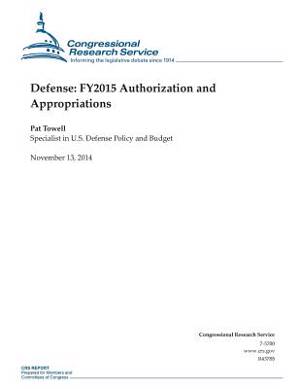
- Retrait gratuit dans votre magasin Club
- 7.000.000 titres dans notre catalogue
- Payer en toute sécurité
- Toujours un magasin près de chez vous
- Retrait gratuit dans votre magasin Club
- 7.000.000 titres dans notre catalogue
- Payer en toute sécurité
- Toujours un magasin près de chez vous
Description
In contrast with the debate over the FY2014 defense budget, congressional action on the FY2015 Department of Defense (DOD) budget request was not complicated by disputes over the total amount at issue. President Obama's FY2015 DOD budget request, the versions of the FY2015 National Defense Authorization Act (NDAA) drafted by the Armed Services Committees of both the House and the Senate, and the versions of the FY2015 DOD appropriations bill drafted by the House and Senate Appropriations Committees all were consistent with the binding cap on defense spending in FY2015 that had been established by the Balanced Budget Act of 2013 (P.L. 113-67). For the NDAA (which includes defense-related nuclear programs conducted by the Energy Department as well as DOD), the President requested authorizations totaling $495.5 billion for DOD's FY2015 so-called "base budget"-that is, the part of the budget not associated with operations in Afghanistan or other situations designated by the President as emergencies. The base budget amounts that would be authorized by the version of the FY2015 NDAA passed by the House (H.R. 4435) and the version reported by the Senate Armed Services Committee (S. 2410) each exceed the President's request by less than $500 million-about one-tenth of 1%. (See Table For so-called Overseas Contingency Operations (OCO)-principally operations in Afghanistan and related activities-the President included in his initial FY2015 budget request a placeholder amount ($79.4 billion) pending a decision on the number of U.S. troops that would remain in Afghanistan for any part of FY2015. The House version of the bill would authorize the place-holder OCO amount while the Senate committee bill would authorize OCO appropriations without specifying an amount. The House and Senate versions of the NDAA each would prohibit some of the cost-reduction initiatives incorporated into the Administration's budget request including a new round of base closures, the retirement of various types of Air Force planes (including the A-10 tank-buster), and changes in the military commissary system. However the Senate bill would allow some of the Administration proposals which the House bill would block, including reductions in the rate of increase of military basic pay and housing allowances, temporarily laying up some warships, and the transfer of Apache helicopters from the National Guard to active-duty Army units. (See Table 12, Table 13, and Table 14.)
Spécifications
Parties prenantes
- Auteur(s) :
- Editeur:
Contenu
- Nombre de pages :
- 94
- Langue:
- Anglais
- Collection :
Caractéristiques
- EAN:
- 9781505203769
- Date de parution :
- 13-11-14
- Format:
- Livre broché
- Format numérique:
- Trade paperback (VS)
- Dimensions :
- 216 mm x 280 mm
- Poids :
- 240 g







